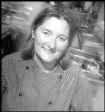Winding through the green sea of pea-vines, cars jam the Rentonesque curves of the two-lane road into town. Tulip fields yell “fuchsia!” in the distance. And cars are stopped dead in their treads.
Nobody’s going anywhere—LaConner’s having a parade.
While drivers on the LaConnerWhitney road thrum fingers on steering wheels and yell at their kids in the backseat, well-lubed Shriners from Mountlake Terrace march down Morris Street in satin turbans and polyester caftans, posing for the tourists. There’s a 78-year-old, half-naked, high-stepping genie with a remarkably large jewel in his remarkably large navel; a calliope; kids dressed as tulips and insects; parents marching for higher teachers’ wages. . . .
“I love this,” says Katie Berg. “This parade is for us. Tourists are lined up all the way out to the freeway—let ’em wait.”
LaConnerites, of course don’t all agree. “This parade used to be held in September, when we get our town back from the tourists,” says LaConner Town Council member Dan O’Donnell. “Blocking off streets at such a busy time is unnecessarily inconvenient to those of us who live here.”
Differing points of view have characterized this town from its muddy beginnings. It used to be said that LaConner had two grocery stores, two gas stations, and two people. Today, one of the gas stations is a deli, one of the groceries is an antique store, and there are a lot more people and a lot more opinions.
This wasn’t always a gift-based economy. LaConner once boomed as the only port on the Skagit River for years. It was known as an up-to-date town with good hotels and restaurants, and numerous and fine whorehouses. Money flowed from timber and fish, none from ice-cream cones. Nothing was colored “oatmeal” except the hot cereal itself.
Bypassed by the railroad in favor of Burlington in 1889, LaConner was left in the backwaters for decades—until 1937, in fact, when painter Morris Graves came to town. Bearded, wearing a rope in place of a belt, he lived in poverty by choice, and was at first not treated particularly well. “People didn’t know what to make of him,” says novelist Tom Robbins, who’s lived in LaConner since 1970. “The words ‘beatnik’ and ‘hippie’ hadn’t been coined, the word ‘bohemian’ wasn’t known in Skagit County, so they called him a ‘Nazi’—the only derogatory term they could come up with. But he won them over, because Morris is a man of tremendous charm.”
Because of the ice broken by Graves, LaConner achieved a sophistication not usually found in rural communities, and the town attracted such artists as Guy Anderson, Mark Tobey, and Ken Callahan, inspiring along the way Richard Gilkey and other locals to try art. Life magazine in 1953 dubbed them the “Mystic Painters of the Northwest,” their work the “Northwest School.” It was the first flicker of recognition for artists from the West by the East Coast art establishment, and they soon were acclaimed internationally. A new generation of artists and bohemians—Robbins, Charlie Krafft, Paul Hansen, Clayton James, Bill Slater—came in the ’60s and ’70s. By then, locals had a name for them: hippies.
“You could be yourself to the fullest extent; the town had a high tolerance for people who liked an easier way of life, where their eccentricities—dress and unusual behavior—were tolerated no matter how vile,” says Robbins.
THE DOG-SLEEPING-in-the-middle-of-First-Street era ended in 1974, when the town, after great debate, installed sewers. Septic tanks had always bubbled up in back yards at high tide, and the toilets of the few storefronts not boarded up flushed directly into the channel. No new building had been allowed for the previous 40 years.
“When they put the sewer in, that’s when this town started going wrong,” says Robbins. Renovation of old houses and crumbling storefronts began, and vacant lots began filling up. A gated community called Shelter Bay sprang up on the Swinomish Reservation just across the Rainbow Bridge, bringing with it an upper-income suburban population that now is to LaConner what Bellevue is to Seattle.
Inexorably, “cute” started replacing “quaint.”
Tulips had been blaring away in spring for 50 years, but had mostly gone unheard. “When I came here 23 years ago,” art dealer and gallery owner Janet Huston says, “you could go out into the fields and be alone—it was spectacular and spiritual.” The blooming masses of color, vibrant and amazing, inspired less spiritual types to fling off their dirndls and cavort naked in the rows.
But alas, no more. In 1982, a Seattle travel agent “discovered” the blooms, and one fateful day the first tour bus rolled into town. “We thought they’d lost their way to Anacortes,” says a native. But no—they’d just come from the tulip fields, and boy were they hungry! Like all tourists, they needed a bathroom, a postcard, and a tchotchke. LaConner leapt into the breach, and has been paying for it ever since.
These days, such tourist needs as T-shirts, ice-cream cones, and espresso are met—and then some. LaConner’s gone gifty, turning itself into a Noah’s ark of retail. Lions lie down with the humpbacks, orcas breach with swordfish, flamingos fly with mallards in figurines, statuary, squeak toys, and paintings, or on coasters, lamp shades, sweatshirts, and the ubiquitous key chain. There are birds with hats, bees with shoes, frogs with glasses, and rabbits every way but cooked: in velveteen, satin, gingham, denim, ceramic, burlap, and rubber, wearing cloches and bonnets, sombreros and baseball caps.
The hardware store has become an upper-income retirement home. The indomitable Skagit Bay Books is long gone, and the only remaining bookstore carries a scant and sad mix of Christian best-sellers, Dr. Laura, and John Grisham served between layers of scented candles and plaqued homilies.
Not all of LaConner has been reduced to selling tourist crap; there are many quality shops and galleries with tasteful wares, but many locals feel downtown is not their own, even with good merchandise. “Downtown is like a city neighborhood you avoid,” says a resident, “except it’s not dangerous, it’s boring.” And useless unless you need a nylon windsock or a wooden tulip. Locals can’t buy shoes or affordable kids’ clothes, or take stuff to the cleaners. They complain that many retailers live elsewhere and don’t care about much except the tourist trade. “Nobody knows you downtown anymore except at the post office,” says Maddy O’Donnell. “The merchants call you ‘ma’am.’ We’re not used to that.”
Except for gas, groceries, and pharmaceuticals, residents shop for necessities in Mount Vernon or Burlington, miles away. Businesses serving “real people” (that’s LaConnerese for “non-tourists”) suffer through tulip season, when regulars avoid town because of traffic gridlock.
While the town’s cat boutique never missed a beat, NAPA Auto Parts closed for 10 days this year during tulip season. “That hurts,” says owner Bonnie Horton. “A lot of our customers are farmers who don’t grow tulips; they have trouble moving equipment on farm roads when getting into their fields is crucial.” Things aren’t much better for Joel Brock, one of the few working artists left in town. His studio-gallery attracts serious art buyers interested in his Skagit landscapes, but the tourism industry’s “crowds pretty much scare away my kind of customers,” he says.
“I never go downtown, there’s nothing to buy,” says Alta Boling, 86, who moved here in 1949. She lives in the quiet world on the hill high above the bustle and roar of the potpourri joints and is known for speaking up. Her life is usually simple. Because she has trouble walking, she mounts her 1970 Bonneville (200,000 original miles, runs good) and drives daily to the post office where the real people in LaConner meet (the action’s in the morning). The ritual is denied her during tulips—there’s no parking, and the temporary one-way streets confuse her. When we spoke, she hadn’t been out of her house for 10 days except to pick up her mail in the evening.
Bob Raymond is the president of Livable LaConner, a watchdog group that, among other things, wants to limit “excessive reliance” on tourism and supports businesses that pay living-wage jobs and provide goods and services for residents. Though this may be largely a matter of closing the gate after the horse is gone, he says, “to me, the issue is, how much displacement by visitors can a town withstand and still maintain its identity and cohesiveness?”
The forces militating against a diversified economy are many, and include LaConner’s isolation, its lack of buildable land, and the rapid-fire growth of tourism in the Northwest. Fishing, fish processing, and timber are gone for good. The largest single payroll is the school’s. Most jobs are in the service of tourists and many do not pay living wages. A yacht-manufacturing concern, Pacific Mariner, employs 84, but for want of skilled workers hasn’t hired many townspeople; young and blue-collar families can’t afford to live there. And while other towns might be able to create affordable housing by sprawling, LaConner can’t. “We’re bound by farmland on one side, water on the other, so our growth is limited to about 1 square mile,” says Mayor Bud Moore. That makes property expensive and rentals scarce. “We’re turning into a retirement community; young people move away.” Southfield, 32 units of housing for lower- and middle-income people, was recently approved, but not without years of fierce opposition—customary in LaConner, where the democratic process is a popular blood sport. “Horror stories of graffiti, crime, dead cars, even false rumors of a quota of mental patients were spread by opponents,” said Linda Pettit, program supervisor for the project.
Among proponents of scarce and expensive housing is Wayne Everton, chair of Viable LaConner, a pro-business, property-rights group that opposed Southfield and champions what Everton calls “controlled growth.” The high cost of housing, Everton continues, “keeps out the riffraff.” Everton came to LaConner 17 years ago and is a good-humored veteran of the war of attrition that is town politics. “We couldn’t get a traffic light on Morris Street,” he says with a laugh, “because the planning commission couldn’t agree on a color scheme.” Turning philosophical, he continues, “‘Livable’ seems to mean turning private property into community property. ‘Viable’ means working with developers to create a living town.”
Yet a living town with a sparse younger generation has inherent viability problems. An immediate one: not enough young people to replace the aging volunteer fire department membership, which could lead to the hiring of costly paid firefighters and the loss of more community feeling.
For all of LaConner’s current problems, Tom Robbins insists that he wouldn’t live anywhere else. “I’m happy as a sugar bug on a rump roast,” he says. Even so, “the insidious result of tourism is that it deadens the soul of a place and probably deadens the soul of the tourist. The Egyptian pyramids and Stonehenge had their energy sucked out from too many people looking at them. The Mona Lisa has no power as art anymore, it’s been looked at too much. The same thing happens to a town.”
He is particularly chagrined at the Chamber of Commerce’s smarmy-farmy revisionism. “Either deliberately or through ignorance, they’ve never capitalized on the internationally renowned artists who shaped the psychological contours of the town,” he says. “Tugboat towns are a dime a dozen. That this was an intersection of art and fishing and farming is what’s interesting and unusual and singular to this community.” Yet aside from the “surprisingly good” Museum of Northwest Art, and a few good galleries, “Art is out of the equation.”
Across the street from the museum and definitely in the equation is the Thomas Kinkade “signature gallery,” a top-selling store that is part of a California chain. It sells pricey original paintings of hyperrealistic views of Carmel, New England, Paris, or “canvas lithographs” with textured reproductions of the artist’s “actual brush strokes.”
The Tulip hordes are better managed than in the past. “The haphazard, unstructured mishmash we were living with,” says Everton, “was getting worse every year, and we needed to create some sort of order.” The Festival Committee responded by spreading events to other towns, providing shuttle buses and parking. The by-product, of course, was even more commercial involvement. The Town Council gives $2,000 a year to the Tulip Committee, and Bob Raymond and the Livables don’t like it, “nor the fact that the Town [Council] gives the Chamber of Commerce $25,000 each year from hotel/motel money to support . . . efforts to attract more people.” The Tulip Festival is run by neighboring Mount Vernon, who stole the county seat from LaConner in 1884. Some people are still mad about the theft and view the festival as an evil insinuated upon them by the old enemy.
Council member O’Donnell is a former mayor and a number-cruncher who charges through LaConner town politics astride a loose but well-primed cannon. A real estate agent who sides with the Livables, he argues that if you subtract extra costs for police, firefighters, signage, and trash removal from the April sales-tax spike in income, it’s only a break-even proposition for the town. He did the math once and found that if each resident gave the town $2.37, “we’d not have to have the Tulip Festival at all.”
Many would pay in a minute, but it wouldn’t work. Geographically, LaConner is in the direct path of the tourist tsunami no matter what Mount Vernon does. Most accept this inevitability; for some, tourism’s worth the trade-off. Jacques Brunischold, a teacher at the high school says, “We have nice restaurants, my kids can find summer work. To me, that’s better than a town where the dogs run free but is otherwise dead.”
Mild damnation can be heard in the faint praise of publisher Fred Owens, who writes the idiosyncratic and intermittent newspaper the Puget Sound Mail. “Tulip time,” he says, “looks pretty good compared to the war in Yugoslavia.”
Everybody agrees on one thing, though: There are seasons to life in the Skagit and the bloomin’ hell of tulip time is but one. Kris Molesworth, Northwest Bookfest director, thinks a lot about the lives of tulips while commuting to Seattle from her Skagit home. Her favorite part is midsummer, when they dig up the bulbs to let them ripen on top of the dirt in potato sacks. “The effect of hundreds of lumpy sacks,” she says, “arranged in rows, casting long shadows from the late summer sun, is remarkable, quiet, and mysterious, unlike the blooming season.”
Tom Robbins sums it up: “Tulips don’t offend people; people offend people.”







